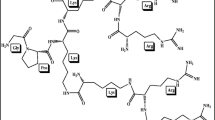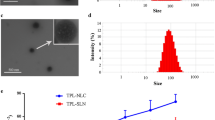ABSTRACT
Purpose
To investigate skin penetration of poly (amidoamine) (PAMAM) dendrimers as a function of surface charge and molecular weight in presence and absence of iontophoresis.
Methods
Dendrimers were labeled with fluoroisothiocynate (FITC); skin penetration of dendrimers was studied using excised porcine skin in-vitro. Skin penetration of FITC-labeled dendrimers was quantified using confocal laser scanning microscope (CLSM). G2-G6 NH2, G3.5-COOH and G4-OH dendrimers were used.
Results
Cationic dendrimers showed higher skin penetration than neutral and anionic dendrimers. Skin penetration of cationic dendrimer increased linearly with increase in treatment time. Iontophoresis enhanced skin penetration of cationic and neutral dendrimers. Increase in current strength and current duration increased skin transport of dendrimers. Passive and iontophoretic skin penetration of cationic dendrimers was inversely related to their molecular weight. Dendrimer penetrated the skin through intercellular lipids and hair follicles. With iontophoresis, dendrimer was also found in localized skin regions.
Conclusions
The study demonstrates that the physicochemical properties of dendrimers influence their skin transport. Findings can be used to design dendrimer-based nanocarriers for drug delivery to skin.















Similar content being viewed by others
REFERENCES
Scheuplein RJ, Blank IH. Permeability of the skin. Physiol Rev. 1971;51:702–47.
Downing DT. Lipid and protein structure in the permeability barrier of mammalian epidermis. J Lipid Res. 1992;33:301–13.
Naik A, Kalia YN, Guy RH. Trbansdermal drug delivery: overcoming skin’s barrier function. Pharm Sci Technol Today. 2000;3:318–26.
Prausnitz MR, Mitragotri S, Langer R. Current status and future potential of transdermal drug delivery. Nat Rev Drug Discov. 2004;3:115–24.
Venuganti VK, Perumal OP. Nanosystems for dermal and transdermal drug delivery. In: Pathak Y, Thassu D, editors. Nanoparticulate drug delivery systems: formulation and characterization. New York: Informa Health; 2009. p. 124–53.
Cevc G, Vierl U. Nanotechnology and the transdermal route: a state of the art review and critical appraisal. J Control Release. 2010;141:277–99.
Esfand R, Tomalia DA. Poly (amidoamine) (PAMAM) dendrimers: From biomimicry to drug delivery and biomedical applications. Drug Discov Today. 2001;6:427–36.
Kannan RM, Perumal O, Kannan S. Dendrimers and hyperbranched polymers in drug delivery. In: Labhateswar V, Pelecky L, editors. Biomedical applications of nanotechnology. New Jersey: Wiley; 2005. p. 105–30.
Mammen M, Choi SK, Whitesides GM. Polyvalent interactions in biological systems: implications for design and use of multivalent ligands and inhibitors. Angew Chem Int Ed. 1998;37:2754–94.
El-Sayed M, Ginski M, Rhodes C, Ghandehari H. Transepithelial transport of poly (amidoamine) dendrimers across Caco-2 cell monolayers. J Control Release. 2002;81:355–65.
Bai S, Ahsan F. Synthesis and evaluation of pegylated dendrimeric nanocarrier for pulmonary delivery of low molecular weight heparin. Pharm Res. 2009;26:539–48.
Vandamme TF, Brobeck L. Poly(amidoamine) dendrimers as ophthalmic vehicles for ocular delivery of pilocarpine nitrate and tropicamide. J Control Release. 2005;102:23–38.
Menjoge AR, Navath RS, Asad A, Kannan S, Kim CJ. Transport and biodistribution of dendrimers across human fetal membrane: implications for intravaginal administration of dendrimer-drug conjugates. Biomaterials. 2010;31:5007–21.
Kitchens KM, Kolhatkar RB, Swaan PW, Eddington NW, Ghandehari H. Transport of poly (amidoamine) dendrimers across caco-2 cell monolayers: influence of size, charge and fluorescent labeling. Pharm Res. 2006;23:2818–26.
Malik N, Wiwattanapatapee R, Klopsch R, Lorenz K, Frey H, Weener JW, et al. Dendrimers: Relationship between structure and biocompatibility in vitro, and preliminary studies on the biodistribution of 125I-labeled polyamidoamine dendrimers in vivo. J Control Release. 2000;65:133–48.
El-Sayed M, Kiani MF, Naimark MD, Hikal AH, Ghandehari H. Extravasation of poly(amidoamine) (PAMAM) dendrimer across microvascular network endothelium. Pharm Res. 2001;18:23–8.
Dufe’s C, Uchegbu IF, Schatzlein AG. Dendrimers in gene delivery. Adv Drug Deliv Rev. 2005;57:2177–202.
Chauhan AS, Sridevi S, Chalasani KB, Jain AK, Jain SK, Jain NK, et al. Dendrimer mediated transdermal delivery: Enhanced bioavailability of indomethacin. J Control Release. 2003;90:335–43.
Venuganti VK, Perumal OP. Effect of poly(amidoamine) PAMAM dendrimer on the skin permeation of 5-fluorouracil. Int J Pharm. 2008;361:230–8.
Venuganti VK, Perumal OP. Poly(amidoamine) dendrimers as skin penetration enhancers: Influence of charge, generation and concentration. J Pharm Sci. 2009;98:2345–56.
Kalia YN, Naik A, Garrison J, Guy RH. Iontophoretic drug delivery. Adv Drug Deliv Rev. 2004;56:619–58.
Jacobi U, Kaiser M, Toll R, Mangelsdorf S, Audring H, Otberg N, et al. Porcine ear skin, an in vitro model for human skin. Skin Res Technol. 2007;31:19–24.
Jevprasesphant R, Penny J, Attwood D, McKeown NB, D’Emanuele A. Engineering of dendrimer surfaces to enhance transepithelial transport and reduce cytotoxicity. Pharm Res. 2003;20:1543–50.
Kalia YN, Pirot F, Guy RH. Homogeneous transport in a heterogeneous membrane: water diffusion across human stratum corneum in vivo. Biophysical J. 1996;71:2692–700.
Diallo MS, Christie S, Swaminathan P, Balogh L, Shi X, Um W, et al. Dendritic chelating agents. 1. Cu(II) binding to ethylenediamine core poly(amidoamine) dendrimers in aqueous solutions. Langmuir. 2004;20:2640–51.
Rastogi SK, Singh J. Lipid extraction and transport of hydrophilic solutes through porcine epidermis. Int J Pharm. 2001;225:75–82.
Turner NG, Ferry L, Price M, Cullander C, Guy RH. Iontophoresis of poly-L-lysines: The role of molecular weight? Pharm Res. 1997;14:1322–133.
Do JH, Joun YS, Chung DJ. Cellular-uptake behavior of polymer nanoparticles into consideration of biosafety. Macromol Res. 2008;16:695–703.
Oh J, Choi S, Lee G, Kim J, Choy J. Inorganic metal hydroxide nanoparticles for targeted cellular uptake through clathrin mediated endocytosis. Chem Asian J. 2009;4:67–73.
Lee JH, Lim Y, Choi S, Lee Y, Kim T, Kim HJ, et al. Polyplexes assembled with internally quartnized PAMAM-OH dendrimer and plasmid DNA have a neutral surface charge and gene delivery potency. Bioconjugate Chem. 2003;14:1214–21.
Nuha P, Davoren M, Lyng FM, Byrne HJ. Reactive oxygen species induced cytokine production and cytotoxicity of PAMAM dendrimers in J774a.1 cells. Toxicol Appl Pharmacol. 2010;246:91–9.
Alvarez-Roman R, Naik A, Kalia YN, Fessi H, Guy RH. Visualization of skin penetration using confocal laser scanning microscopy. Eur J Pharm Biopharm. 2004;58:301–16.
Dubey S, Kalia YN. Non-invasive iontophoretic delivery of enzymatically active ribonuclease A (13.6 kDa) across intact porcine and human skins. J Control Release. 2010;145:203–9.
Brus C, Santi P, Colombo P, Kissel T. Distribution and quantification of polyethyleneimine oligodeoxyneclotide complexes in human skin after iontophoretic delivery using confocal scanning laser microscopy. J Control Release. 2002;84:171–81.
Burnette RR, Ongpipattanakul B. Characterization of the permselective properties of excised human skin during iontophoresis. J Pharm Sci. 1987;76:765–73.
Schuetz YB, Carrupt PA, Naik A, Guy RH, Kalia YN. Structure-permeation relationships for the non-invasive transdermal delivery of cationic peptides by iontophoresis. Eur J Pharm Sci. 2006;29:53–9.
Wu X, Landfester K, Musyanovych A, Guy RH. Disposition of charged nanoparticles after their topical application to the skin. Skin Pharmacol Physiol. 2010;23:117–23.
Perumal OP, Inapagolla R, Kannan S, Kannan RM. The effect of surface functionality on cellular trafficking of dendrimers. Biomaterials. 2008;29:3469–76.
Marro D, Guy RH, Delgado-Charro MB. Characterization of the iontophoretic permselectivity properties of human and pig skin. J Control Release. 2001;70:213–7.
Guy RH, Kalia YN, Delgado-Charro MB, Merino V, Lopez A, Marro D. Iontophoresis: electrorepulsion and electroosmosis. J Control Release. 2000;64:129–32.
Ruddy SB, Hadzija BW. Iontophoretic permeability of polyethylene glycols through hairless rat skin: application of hydrodynamic theory for hindered transport through liquid-filled pores. Drug Des Discov. 1992;8:207–24.
Pikal MJ, Shah S. Transport mechanisms in iontophoresis. III. An experimental study of the contributions of electroosmotic flow and permeability change in transport of low and high molecular weight solutes. Pharm Res. 1990;7:222–9.
Pillai O, Kumar N, Dey CS, Borkute, Sivaprasad N, Panchagnula R. Transdermal iontophoresis of insulin: III. Influence of electronic parameters. Methods Find Exp Clin Pharmacol. 2004;26:399–408.
Cazares-Delgadillo J, Naik A, Ganem-Rondero A, Quintanar-Guerrero D, Kalia YN. Transdermal delivery of cytochrome-c, a 12–4 kDa protein across intact skin by constant current iontophoresis. Pharm Res. 2007;24:1360–8.
Kasting GB, Keister JC. Applications of electrodiffusion theory for a homogenous membrane to iontophoretic transport through skin. J Control Release. 1989;8:195–210.
Hirvonen J, Guy RH. Transdermal iontophoresis: modulation of electroosmosis by polypeptides. J Control Release. 1998;50:283–9.
Potts RO, Guy RH. Predicting skin permeability. Pharm Res. 1992;9:663–9.
Abla N, Naik A, Guy RH, Kalia YN. Effect of charge and molecular weight on transdermal peptide delivery by iontophoresis. Pharm Res. 2005;22:2069–78.
Alvarez-Roman R, Naik A, Kalia YN, Guy RH, Fessi H. Skin penetration and distribution of polymeric nanoparticles. J Control Release. 2004;99:53–62.
Prausnitz MR, Gimm JA, Guy RH, Langer R, Weaver JC, Cullander C. Imaging regions of transport across human stratum corneum during high-voltage and low-voltage exposures. J Pharm Sci. 1996;85:1363–70.
ACKNOWLEDGMENTS
We thank Dr. Kelly Bruns and Mr. Adam Rhody, Meat Science Department, SDSU for providing porcine skin.This work was supported by South Dakota Governor Round’s 2010 individual research seed grant and Department of Pharmaceutical Sciences, South Dakota State University.
Author information
Authors and Affiliations
Corresponding author
Electronic supplementary material
Below is the link to the electronic supplementary material.
Fig. S1
Representative 1H-NMR spectra of G4-NH2, free FITC and G4-NH2-FITC conjugate. Dotted line corresponds to aromatic protons of FITC (6 to 8 ppm), and solid circle corresponds to aliphatic protons in the dendrimer (2 to 4 ppm). (DOCX 158 kb)
Fig. S2
Representative UV-Visible absorbance spectra of G4-NH2dendrimer-FITC conjugate, free FITC and free dendrimer. The λmax for free FITC was495 nm, while the λmax shifted to 500 nm for G4-NH2dendrimer-FITC conjugate. (DOCX 13 kb)
Rights and permissions
About this article
Cite this article
Venuganti, V.V., Sahdev, P., Hildreth, M. et al. Structure-Skin Permeability Relationship of Dendrimers. Pharm Res 28, 2246–2260 (2011). https://doi.org/10.1007/s11095-011-0455-0
Received:
Accepted:
Published:
Issue Date:
DOI: https://doi.org/10.1007/s11095-011-0455-0




